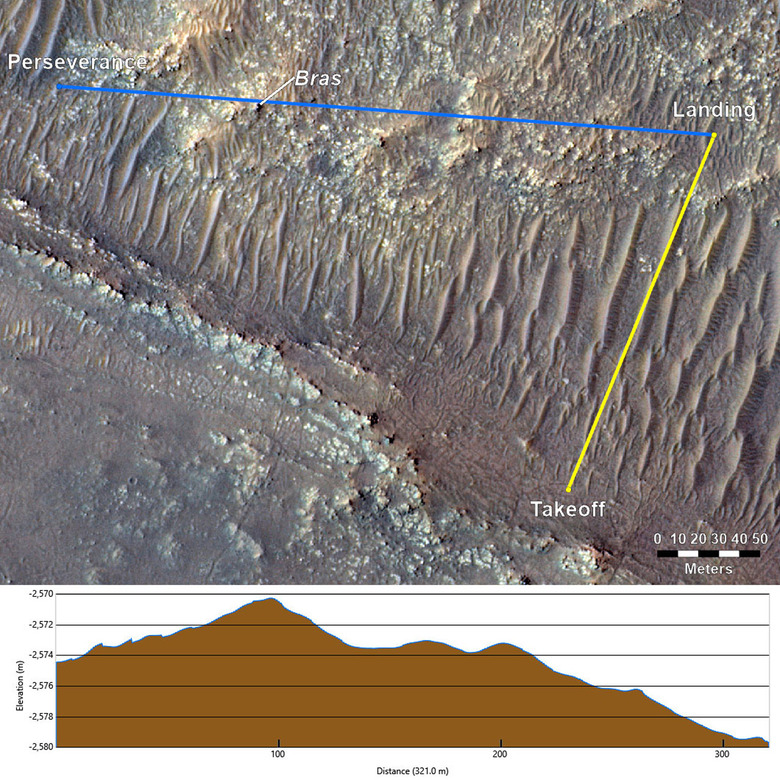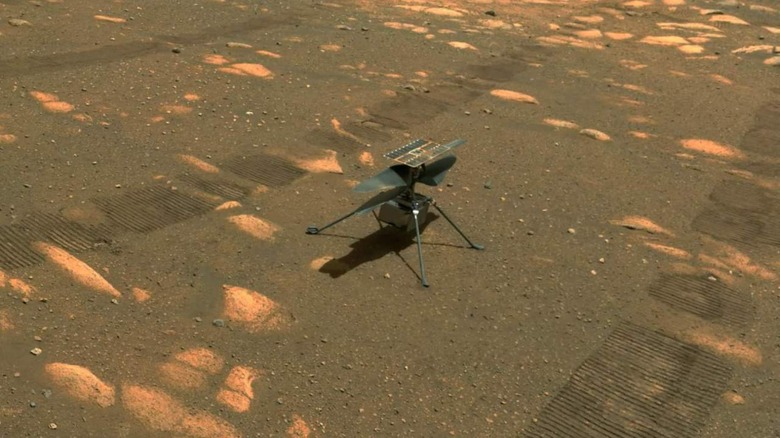NASA Lost Contact With Mars Helicopter Ingenuity For 15 Breathless Minutes
NASA conducted the 17th flight for the Ingenuity Mars Helicopter on Sunday, December 5. Everything went as planned during the helicopter's 614-foot traverse to the northeast. However, during the final descent phase of the flight, the communications link between Ingenuity and the Perseverance Mars rover was disrupted. It appears the helicopter was able to land successfully. Approximately 15 minutes after the radio link was lost, Perseverance received packets of Ingenuity telemetry indicating the battery and flight electronics were healthy.NASA believes the loss of the radio link was due to a "challenging radio configuration" between Perseverance and Ingenuity during the helicopter's landing. Telemetry data NASA from the flight showed that the vehicle performed as expected during the 117-second flight at an altitude of 33 feet above the surface of Mars. However, telemetry data is missing for about a third of the final descent from an altitude of about 10 feet above the Martian surface.
NASA said before it could be sure exactly what happened to cause the loss of radio link, it had to transfer the missing data from Flight 17 from the helicopter to Perseverance and then to Earth. NASA was able to relay that data to Earth on Wednesday of this week, and the data shows that power aboard the helicopter is excellent. The level of power being transferred from the solar panels to the six lithium-ion batteries inside the helicopter is strong enough that NASA believes the helicopter is in an upright stance.

However, the Ingenuity team continues to have line-of-site issues with communications, which they believe caused the loss of telemetry data during the flight. The line-of-site issue has prevented the majority of data packets from being relayed to the rover. Outstanding data packets also include all of the imagery from the flight. NASA says that it expects an opportunity to transfer data in the next several days.
NASA knew Ingenuity would face challenges with the rugged environment where it's currently operating. The helicopter has operated far past its original mission timeline, and it was originally designed to operate on flat land. Currently, it is operating in an area with significant elevation changes that pose challenges not only to the flight software but to the radio signal link between Ingenuity and Perseverance.
The strength of a radio signal depends a lot on having a clear line of sight between the transmitting and receiving antennas. In rugged terrain, the line of sight could be obstructed by large rocks, hills, or ridges. Communications can also be obstructed if Perseverance is aligned so that its receiver faces away from the helicopter. Communications challenges during this flight include a landing site that placed a hill called Bras between the helicopter and the rover. The hill is only 13-feet tall, but that proved enough to hamper communications.
When Flight 17 was planned, controllers believed Perseverance would be parked in a specific location, facing a specific direction. However, plans for Perseverance change day-to-day, and by the time Flight 17 happened, the rover was parked in a different location. The rover's location placed it at a challenging heading for radio communications with Ingenuity.
The design teams behind Ingenuity built the helicopter to handle this type of issue. The helicopter was designed to power down after flight and wait for further instructions automatically. NASA says it believes the flight was a complete success noting that telemetry was nominal leading up to the moment radio communications were lost. A successful landing is further backed up by the data packets received 15 minutes after Ingenuity was supposed to have landed.
Among the data in those packets was battery voltage is indicating +76 millivolts, which is a positive 1.2 percent state of charge increase over 15 minutes. That data shows that the solar panels were charging the battery, and NASA says the high level of charging is only possible if the vehicle was upright with its solar array pointed at the sky.

The image above was captured by the Mars Perseverance rover's Mastcam-Z Camera on SOL 282 (December 5, 2021) at local mean solar time 07:49:18., shared by NASA/JPL-Caltech/ASU
Challenging Conditions
Ingenuity continues operating in conditions above and beyond what it was originally intended to endure. One of the biggest challenges for continued operations was reduced Martian air density as the seasons changed on the Red Planet. The atmosphere on Mars is already significantly less dense than the atmosphere here on Earth. As the seasons changed, NASA had to increase the rotor speed of Ingenuity to allow the helicopter to continue to operate.

With the Martian atmosphere becoming less dense with the new season, NASA increased the rotor speed to 2800 RPM. The higher rotor speed provided the lift needed to keep operating. The current loss of radio communication isn't the first challenge that Ingenuity has overcome.
Previously, a flight was scrubbed in September after an issue with a pair of servos was discovered during a pre-flight checkout. The servos are critical to stable flight, and one theory at the time was that the issue might indicate parts of the servo gearbox and swashplate linkages were beginning to wear. However, the issue doesn't appear to have caused any additional problems for Ingenuity so far.
